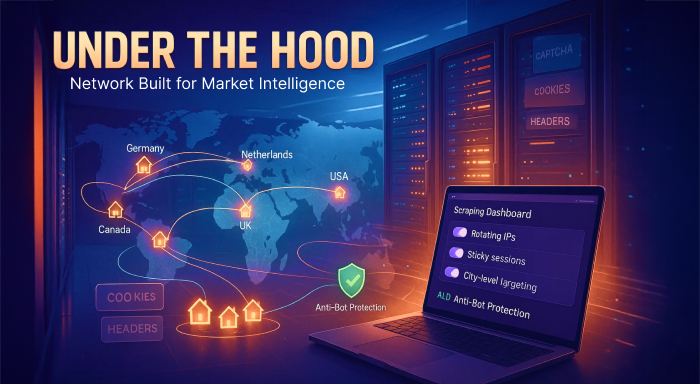E-commerce prices now behave like high-frequency ticker symbols. Amazon alone rewrites about 2.5 million price tags every day, dwarfing the adjustment cadence at Best Buy or Walmart. For brands and marketplace sellers, keeping up is less a matter of curiosity than of survival: missing a rival’s flash markdown by even an hour can push a product off the coveted Buy-Box and vaporize a day’s margin. That urgency is driving a quiet but noticeable shift among market-intelligence teams toward specialist proxy networks, with PlainProxies - a three-year-old German provider—becoming a default name on data-engineering Slack channels.
Price Data Needs Volume, Velocity and a Clean IP Footprint
Retailers do not offer bulk feeds of live prices; they protect them behind login walls, rate limits and CAPTCHAs that will block a single IP after a few dozen requests. A mid-size apparel house monitoring 30,000 SKUs across ten markets generates roughly 15 million page calls every night after currency, color and size permutations are added. At that scale, rotating an IP pool isn’t a convenience—it is the only way scrapers finish before dawn. Proxies can improve your digital privacy, as well as adhering to this kind of data scale, especially when created on large number of residential networks, like 60-million-node. This network can span more than 150 geolocations and advertises a 99.9 percent success rate with sub-second latency. Those numbers place it in the same league as Oxylabs or Bright Data but at a mid-market price point.
Under the Hood: A Network Built for Market Intelligence

PlainProxies rents capacity from five physical datacenters in Germany, the Netherlands, the United States, Canada and the United Kingdom, then layers residential peers on top to imitate real shoppers down to the city level. Customers can request either a “sticky” session that keeps the same IP for 10 minutes—handy when scraping a cart sequence—or a back-connect endpoint that rotates every call. For European VAT audits, analysts often pin the IP to the exact province to see whether cross-border pricing holds. When the script finishes, cookies and headers vanish with the IP, starving anti-bot engines of their breadcrumb trail.
API design is intentionally plain: one back-connect hostname, a username flag for country code, and standard user-agent controls. This streamlined design allows you to use your existing Scrapy, Apify, or Playwright scripts seamlessly, with no need to write a single line of code. Growth teams focused on TikTok Shop say the switch from datacenter proxies to this peer network cut their CAPTCHA failure rate from nine percent to “under one” during Black Friday test crawls last November, a claim echoed in PlainProxies’ own e-commerce use-case page.
How the Numbers Translate on the Ground
Take the London-based beauty marketplace that tracks price, stock status and shipping promises for 12 competitors across eight EU domains. Its nightly harvest is 12.4 million requests, equal to 35 GB of HTML. On PlainProxies’ entry residential tier—€11.50 for 5 GB on a 30-day clock—that single run would cost about €7, but the firm buys the 100-GB plan at €1.50 per gigabyte, each product is processed under two pence so staying within the internal cost targets is crucial. In return, their BI dashboard updates by 06:00, well before competitors change banners for the workday rush.
A North-American electronics brand operates differently. It leans on the €2-per-month datacenter proxy slots to ping warranty-parts distributors, saving residential bandwidth for high-risk targets like Amazon or Mercado Libre. The mix-and-match catalog—IPv6 for bulk stock checks, ISP proxies for ad-verification—lets teams dial cost versus stealth without migrating vendors every quarter. In many conditions, they have initiated integrating SOCKS5 proxies for tools needing high obscurity, greater solidarity with headless browsers.
Reliability Becomes a KPI, Not an SLA Clause
PlainProxies claims “hundreds of engineers” as active users, and while that is a marketing metric, Trustpilot threads back the sentiment: users consistently cite stable throughput over exotic features. Third-party reviewers at RapidSeedbox noted the provider’s “rapid and stable performance” and tagged 2022 as its founding year—a blink compared with decade-old incumbents but enough time to iron out routing kinks. The company ships weekly network-health e-mails summarising packet loss by region; one European retailer shared logs showing less than 0.3 percent dropped requests during the May VAT-free day, when traffic spiked 5×.
Competitive Context and the Road Ahead
The proxy market itself is fragmenting. Proxyway’s 2025 industry report tracks at least eleven sizeable vendors, yet PlainProxies did not even enter the study, reflecting both its challenger status and its focus on a narrower slice of users: operators who scrape first and ask questions later. While Oxylabs focuses on meeting Fortune 500 compliance guidelines and Bright Data emphasizes fully managed datasets, PlainProxies is positioning itself as the just-give-me-IPs supplier with clear and gigabyte billing.
That stance resonates with e-commerce specialists who value predictable costs over bundled dashboards. The roadmap published to customers in June promises residential exit nodes in Indonesia and a SOCKS5 option for head-less browsers—two gaps highlighted in a March Multilogin blog review. If the company hits those milestones without diluting performance, its functional minimalism could turn into a defensible niche.
Bottom Line
Market intelligence has crossed the rubicon from quarterly study to minute-by-minute telemetry. When prices mutate millions of times a day, only a proxy layer large enough to impersonate the internet can feed the algorithms that set tomorrow’s markup. PlainProxies’ blend of scale, geodiversity and no-frills pricing gives data teams an IP firehose without the enterprise sticker shock. For e-commerce experts juggling margins in real time, that may be the edge between reacting to the market and defining it.




%201.png)

%201.png)

%201.png)

